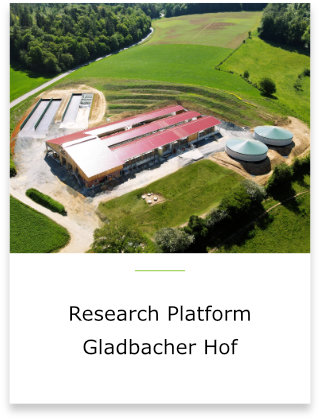Infrastructure
 |
Research Platform Gladbacher HofThe project uses the innovative dairy farming system of the organically managed Gladbacherhof at Justus Liebig University (JLU) Giessen. The Gladbacherhof is a Hessian state domain and has served the Justus Liebig University Giessen as a teaching and experimental farm for organic farming since 1990. A new dairy facility on the Gladbacherhof site (to be completed in early 2022) will allow scientific comparison of high-input and low-input dairy farming systems with digital animal recording, grazing control, and robotic feeding and milking. Low-input systems with grazing and predominantly roughage from grassland have been considered the standard on organic dairy farms. Alternatively, in the high-input system with grazing, the animals are also fed a high proportion of the farm's own corn silage and concentrated feed from cereals and field beans. To account for the different animal populations and feeding systems, GreenDairy is creating two interwoven core experiments. The livestock core experiment and the arable core experiment will provide a comprehensive data set for integrated systems analysis and economic evaluation.
|
|
|---|
 |
Core Experiment LivestockAt the heart of the project are two cow herds (64 cows each) divided into high-input and low-input herds. The main difference between the rations of the high-input and low-input animals is the proportion of corn silage and concentrated feed. Each herd has access to a milking robot that individually records the amount of milk and the different milk components. The milk is stored herd by herd in separate tanks until collection. The exact daily feed intake of the herd is recorded using feeding robots. After morning feeding in the barn, cows have daily access to pasture during the grazing season, with allocation of pasture controlled by sensors based on group membership. Separate manure storage facilities next to the barn allow for herd-specific collection of excrement.
|
|
|---|
 |
Core Experiment CropAn "crop production" and " grassland " exact experiment will be set up in the immediate vicinity of the new dairy farm, with crop rotations and fertilization that reflect the characteristics of the core livestock experiment (high vs. low-input dairy production). By analogy with livestock production, the high-input and low-input farming systems are compared. A total of 64 plots with 2 management systems, an 8-year crop rotation, and 4 replications are studied in an exact cropping experiment.The exact grassland experiment reflects the characteristics of a permanent grassland for grass silage production with variations in manure application (raw manure before separation, thin manure after separation). Sixteen plots with a four-way combination are studied. Daily grazing will occur on the newly established silvopastoral agroforestry systems in close proximity to the currently constructed dairy facility (scheduled for completion in early 2022).
|
|
|---|









